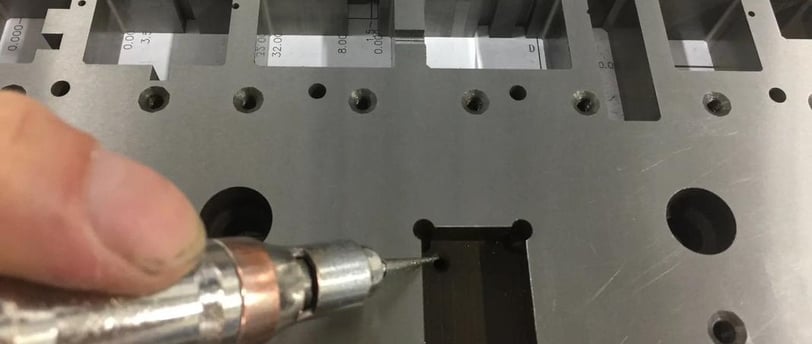Hardware Stamping Mold Manufacturing Process and Key Steps
1/22/2025


Understanding Hardware Stamping Molds
Hardware stamping molds are integral tools used in the manufacturing process, primarily for shaping and forming metals and other materials into specific designs. These molds facilitate the stamping process, a method which involves applying force to material to produce detailed components efficiently and accurately. The manufacturing sector relies heavily on this technique for the mass production of parts utilized in various applications, including automotive, aerospace, and electronics.
There are several types of hardware stamping molds, with progressive and transfer molds being two of the most commonly utilized forms. Progressive molds allow for continuous production, moving the material through a series of stations where it is progressively shaped into the final product. This type of mold is renowned for its efficiency, particularly in high-volume production scenarios. Conversely, transfer molds typically involve the movement of shaped parts from one station to another, making them suitable for complex designs that require several operations. Each type of mold plays a pivotal role in determining the production speed and the complexity of the parts manufactured.
The materials selected for constructing hardware stamping molds significantly impact the overall performance and longevity of the molds. Typically, high-strength steels and alloys are employed, given their ability to withstand the extreme pressures associated with the stamping process. The choice of material not only affects the durability of the molds but also influences the quality of the finished product, particularly in terms of precision and surface finish. Optimal material selection ensures that manufacturers can achieve consistent quality in the parts produced, thus meeting stringent industry standards.
The Key Steps in the Manufacturing Process
The manufacturing process of hardware stamping molds involves several key steps, each integral to ensuring a high-quality final product. The journey begins with the initial design phase, where engineers and designers collaborate to develop precise technical drawings. This stage utilizes computer-aided design (CAD) software to create detailed representations of the mold, facilitating the identification and resolution of any potential design challenges early in the project.
Following the design approval, the process advances to prototyping. During this stage, a prototype mold is created to test the design's feasibility and functionality. This step is critical as it allows for adjustments to be made before full-scale production begins, minimizing the risk of costly errors later. Techniques such as 3D printing may be employed to create the prototype quickly and efficiently.
Once the prototype is validated, the focus shifts to the fabrication of the mold components. This phase employs high-precision machinery, including CNC milling machines and electrical discharge machining (EDM) tools, to produce intricate parts of the mold. Each component must be fabricated with meticulous attention to detail to ensure proper fit and function in the assembly phase.
After the individual parts are completed, assembly takes place. Skilled technicians meticulously piece together the various components, ensuring that they mesh accurately. The assembly is a critical factor in the overall precision of the stamping mold, as even slight misalignment can result in defects during the stamping process.
Quality control measures are paramount throughout all these stages. Rigorous testing and inspections are conducted to verify that the molds meet industry standards. These checks include dimensional verification, material testing, and performance evaluations, ensuring that the final product will perform reliably in production. The emphasis on precision and quality at every step is what ultimately defines the efficacy and durability of hardware stamping molds.
Choosing the Right Materials and Techniques
The selection of appropriate materials is a critical factor in the manufacturing process of hardware stamping molds. Different types of metals and alloys exhibit varying properties that directly influence the mold's effectiveness, durability, and performance. Commonly used materials include tool steels, aluminum, and various grades of stainless steel. Tool steels, such as D2 or A2, offer remarkable hardness and wear resistance, making them suitable for high-volume production environments where precision is paramount.
Aluminum, while not as hard as tool steel, provides a lighter alternative and exhibits excellent machinability. Its use is particularly beneficial in low to medium-volume applications where weight reduction is crucial. On the other hand, stainless steel combines both strength and corrosion resistance, making it useful in environments where moisture or chemicals may be present, ensuring longevity and reduced maintenance costs.
After selecting the right material, the techniques employed in machining and finishing the molds greatly impact their quality and lifespan. Advanced cutting methods such as Electrical Discharge Machining (EDM) and CNC milling offer enhanced precision, allowing for intricate designs and tighter tolerances. Equally important is finishing, which includes processes such as grinding, polishing, and surface coating. These techniques not only improve the mold's aesthetic but also contribute to its functionality by reducing friction and increasing resistance to wear.
Heat treatment is another vital technique that alters the physical properties of the metals, enhancing their hardness and overall performance. This process involves controlled heating and cooling, enabling manufacturers to achieve desired characteristics based on the application's needs. Ultimately, careful consideration of material selection coupled with proficient machining and finishing techniques will ensure the efficiency and long-term success of hardware stamping molds.
Challenges and Solutions in Mold Manufacturing
The hardware stamping mold manufacturing process presents various challenges that can impede production efficiency and ultimately affect product quality. One of the significant challenges is wear and tear on the molds themselves. The materials used in stamping processes often experience substantial friction and pressure, leading to degradation over time. This progressive wear can compromise the accuracy of the formed parts and necessitate frequent repairs or replacements, which can be costly and time-consuming.
Another common challenge arises from design imperfections in the mold. When designs are not meticulously planned, they can lead to defects in the final product. Design flaws may be due to inadequate modeling, incorrect specifications, or failure to account for material properties. Such discrepancies can result in wasted materials and prolonged production timelines. It is vital for manufacturers to adopt rigorous design review processes that leverage advanced software and simulation tools to mitigate this risk.
Production delays are also a frequent concern associated with hardware stamping mold manufacturing. Factors such as equipment malfunctions, supply chain disruptions, or even labor shortages can halt production and lead to missed deadlines. Manufacturers can adopt lean manufacturing principles to streamline operations, which may involve optimizing workflow, reducing waste, and enhancing communication between teams.
To address these challenges effectively, advancements in technology play a crucial role. Employing high-quality materials for mold construction can enhance durability and reduce wear. Additionally, utilizing modern manufacturing techniques such as additive manufacturing can allow for more intricate designs while minimizing the likelihood of imperfections. Implementing robust maintenance routines further ensures that equipment operates smoothly and reliably.
By understanding and addressing these common challenges in hardware stamping mold manufacturing, organizations can improve their operational resilience, reduce risks, and ensure a higher quality and reliability of their stamping molds. This proactive approach not only safeguards production outputs but also enhances competitiveness in the industry.
